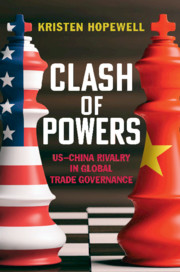Book contents
- Clash of Powers
- Clash of Powers
- Copyright page
- Contents
- Figures
- Tables
- Acknowledgments
- Introduction
- 1 The Doha Round Impasse
- 2 The New Politics of Agricultural Subsidies: A US–China Battle
- 3 The Dragon in the World’s Oceans: Fisheries Subsidies
- 4 Beyond the WTO: Erosion of the Export Credit Arrangement
- 5 Negotiating in the Dragon’s Shadow: Export Credit for Coal Plants
- Conclusion
- Notes
- References
- Index
2 - The New Politics of Agricultural Subsidies: A US–China Battle
Published online by Cambridge University Press: 21 January 2021
- Clash of Powers
- Clash of Powers
- Copyright page
- Contents
- Figures
- Tables
- Acknowledgments
- Introduction
- 1 The Doha Round Impasse
- 2 The New Politics of Agricultural Subsidies: A US–China Battle
- 3 The Dragon in the World’s Oceans: Fisheries Subsidies
- 4 Beyond the WTO: Erosion of the Export Credit Arrangement
- 5 Negotiating in the Dragon’s Shadow: Export Credit for Coal Plants
- Conclusion
- Notes
- References
- Index
Summary
China’s rise has transformed the global politics of agricultural subsidies, which is among the most controversial issues in the trading system. China has emerged as the world’s largest subsidizer, upending the entrenched understanding of agricultural subsidies as a harm perpetrated by the Global North upon the Global South. From a North-South battle, WTO negotiations on agricultural subsidies have been transformed into a conflict centered on the US and China. The US, as the world’s largest agricultural exporter, is eager to restrain China’s subsidies and insists that it will only agree to stricter rules on its own subsidies if they also apply to China. But China has refused, insisting that as a developing country, it should be exempt from any new restrictions on subsidies. The US has been unable to force China to accept disciplines on its subsidies, leading to a stalemate. While reducing trade-distorting subsidies remains a pressing concern for developing countries, efforts to negotiate new and strengthened disciplines at the WTO have been paralyzed by an impasse between the two dominant powers, heavily shaped by the hegemonic rivalry between the two states. China, along with the US, is now blocking pro-development reform of the trading system at the WTO.
Keywords
- Type
- Chapter
- Information
- Clash of PowersUS-China Rivalry in Global Trade Governance, pp. 60 - 93Publisher: Cambridge University PressPrint publication year: 2020
- 1
- Cited by



